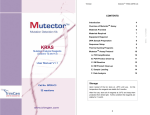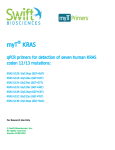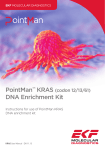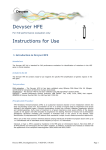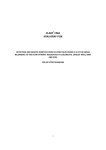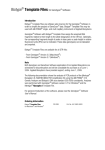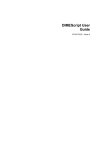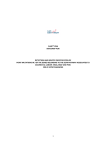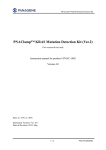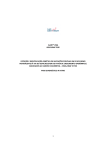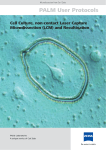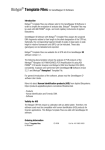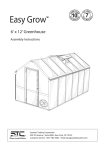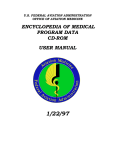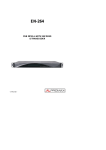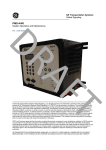Download My Document
Transcript
Devyser KRAS-BRAF Art. No.: 8-A050 For in vitro Diagnostic Use Instructions for Use Devyser KRAS-BRAF, CE-IVD, 7-A021-EN, v1-2012 © Devyser AB, 2012 Page 1 of 23 Table of Contents Table of Contents 1. Introduction to Devyser KRAS-BRAF Intended use Included in the kit Test procedure Background Principle of the Procedure 2. Warnings and Precautions 3. Symbols used on Labels 4. Required Material 4.1 Included in the Devyser KRAS-BRAF kit (#8-A050) Configuration Components 4.2 Required but Not Provided Reagent Preparation DNA Extraction Amplification Detection Size Standard: 4.3 Dye Set Calibration: 5. Storage and Handling Requirements 6. Sample Requirements Clinical Samples Procedure & Storage Controls 7. Instructions for Use Run Sizes 7.1 Workflow Devyser KRAS-BRAF kit (Art # 8-A050) 7.2 Sample Preparation and PCR Amplification DNA Extraction Addition of Sample Amplification Amplification Area: 7.3 Detection Sample preparation Sample Preparation for capillary electrophoresis Instrument Preparation Run Modules 8. Results and Analysis Pre-analytic amplification control (PAC) Devyser KRAS-BRAF, CE-IVD, 7-A021-EN, v1-2012 © Devyser AB, 2012 2 4 4 4 4 4 4 6 7 8 8 8 8 8 8 8 8 8 8 9 10 11 11 11 11 12 12 12 12 12 13 13 13 14 14 14 15 15 16 16 Page 2 of 23 KRAS and BRAF mutation analysis Table 2. Summary of PCR fragments detected Example data 9. Performance Characteristics Sensitivity of the Devyser KRAS-BRAF kit Cross reactivity Clinical performance 10. Procedural Limitations 11. Notice to Purchaser 12. Contact Information Devyser KRAS-BRAF, CE-IVD, 7-A021-EN, v1-2012 © Devyser AB, 2012 17 18 18 20 20 20 20 21 22 23 Page 3 of 23 1. Introduction to Devyser KRAS-BRAF Intended use The Devyser KRAS-BRAF kit is an in vitro diagnostic kit for identification of mutations in the KRAS and BRAF genes. Devyser KRAS-BRAF is not intended to diagnose cancer. The results from Devyser KRAS-BRAF are intended to be used as an aid to the selection of appropriate drug therapy treatment for patients with colorectal cancer. Clinical decisions for patient treatment should not be made based on the results of Devyser KRAS-BRAF alone. Included in the kit The Devyser KRAS-BRAF kit contains ready-to-use reagents for PCR amplification of genetic markers. Test procedure DNA extraction: The Devyser KRAS-BRAF kit has been validated using the QIAamp DNA FFPE Tissue Kit (Qiagen, cat#56404) for extraction of DNA from formalin fixed paraffin embedded (FFPE) tissue samples. RNase A treatment during DNA extraction is essential for optimal results. Amplification: The Devyser KRAS-BRAF kit has been validated using ABI GeneAmp® Systems 9700. Detection: Applied Biosystems Genetic Analyzers (ABI PRISM® 310, 3100, 3130, 3500, 3730) that support the detection of Devyser Dye-Set DEV-5 or ABI Dye-Set D (DS-30). Background Mutations in KRAS and BRAF genes can indicate prognosis and might prevent the therapeutic success of anti-EGFR therapies since tumors carrying mutant forms of the KRAS and BRAF genes are less likely to respond to anti-EGFR therapy. Testing for KRAS and BRAF mutations can facilitate the identification of tumors that will not respond to anti-EGFR drugs and shortening the time for identifying alternative treatment options. Principle of the Procedure The method employed by the Devyser KRAS-BRAF kit uses multiplex allele specific PCR amplification for detection of point mutations in the KRAS and BRAF genes. The PCR products generated are analysed by capillary electrophoresis (CE) and fluorescent detection on a CE instrument. Devyser KRAS-BRAF, CE-IVD, 7-A021-EN, v1-2012 © Devyser AB, 2012 Page 4 of 23 The kit also includes a pre-analytic amplification control (PAC). It is recommended that the PAC is used to confirm the presence of amplifiable DNA in a clinical sample before performing the KRAS and BRAF mutation analysis. Devyser KRAS-BRAF, CE-IVD, 7-A021-EN, v1-2012 © Devyser AB, 2012 Page 5 of 23 2. Warnings and Precautions A. Devyser KRAS-BRAF has been validated using a total PCR reaction volume of 25 µl. Changing the reaction volume will compromise the kit performance. B. Avoid microbial contamination of reagents when removing aliquots from reagent tubes. The use of sterile disposable aerosol barrier pipette tips is recommended. C. Do not pool reagents from different lots or from different tubes of the same lot. D. Do not use a kit after its expiry date. E. Do not use opened or damaged kit reagent tubes. F. Workflow in the laboratory should proceed in a unidirectional manner, beginning in the reagent preparation area and moving to the DNA extraction area and then to the amplification area and finally to the detection area. Pre-amplification activities should begin with reagent preparation and proceed to DNA extraction. Reagent preparation activities and DNA extraction activities should be performed in separate areas. Supplies and equipment should be dedicated to each activity and not used for other activities or moved between areas. Gloves should be worn in each area and should be changed before leaving that area. Equipment and supplies used for reagent preparation should not be used for DNA extraction activities or for pipetting or processing amplified DNA or other sources of target DNA. Amplification and detection supplies and equipment should remain in the amplification and detection area at all times. G. Handling of kit components and samples, their use, storage and disposal should be in accordance with the procedures defined by national biohazard safety guidelines or regulations. H. Wear powder free disposable gloves, laboratory coats and eye protection when handling specimens and kit reagents. Wash hands thoroughly after handling specimens and kit reagents. Devyser KRAS-BRAF, CE-IVD, 7-A021-EN, v1-2012 © Devyser AB, 2012 Page 6 of 23 3. Symbols used on Labels Lot or batch number Expiry date Manufacturer Number of tests In vitro diagnostic device Store below temperature shown Devyser KRAS-BRAF, CE-IVD, 7-A021-EN, v1-2012 © Devyser AB, 2012 Page 7 of 23 4. Required Material 4.1 Included in the Devyser KRAS-BRAF kit (#8-A050) Configuration The Devyser KRAS-BRAF kit contains reagents for analysis of maximum 25 samples. Components Cap Colour Tube Colour Label Art.Nr. Kit Content Orange White Yellow Clear Amber Amber PCR Activator Devyser KRAS-BRAF Mix Devyser PAC Mix 4-A018 4-A132 4-A141 2 x 25 Tests 1 x 25 Tests 1 x 25 Tests 4.2 Required but Not Provided Reagent Preparation · Consumables for the Thermal Cycler · Micropipette/dispenser with aerosol barrier tips or displacement tips (500 µl) · Disposable protective gloves (powder free) DNA Extraction · Reagents and equipment according to manufacturer instructions for use · RNase A (Qiagen art. No.: 19101) · Micropipette/multipipette with aerosol barrier tips Amplification · Thermal Cycler: ABI GeneAmp® PCR System 9700 using 9600 mode. For use of alternative thermal cyclers the following ramping rates must be applied: heating @ 0.8 C/s, cooling @ 1.6 C/s · Micropipette/dispenser with aerosol barrier tips or displacement tips (5, 20 µl) Detection · Applied Biosystems Genetic Analyzer (ABI 310, 3100, 3130, 3500, 3730) · Performance optimized polymers: POP-4 or POP-7 · Hi-Di Formamide, Genetic Analysis Grade · 1x Genetic Analyzer Buffer · Micropipette/multipipette/dispenser with aerosol barrier tips or displacement tips (1,5 uL, 15 uL) Size Standard: Devyser Dye Set DEV-5: 560 SIZER ORANGE (Devyser cat.# 8-A402) Devyser KRAS-BRAF, CE-IVD, 7-A021-EN, v1-2012 © Devyser AB, 2012 Page 8 of 23 ABI Dye Set D: Gene-Scan-500 ROX Size Standard (ABI cat.#401734/#4310366) 4.3 Dye Set Calibration: ABI 3100, 3130, 3730 Use DEV-5 Dye Set MultiCap kit (Devyser cat# 8-A401) in the “Any5Dye” dye-set or DS-30 Matrix Standard Kit (ABI cat.#4345827) in Dye set D. ABI 3500 Use DEV-5 Dye Set MultiCap kit (Devyser cat# 8-A401) and generate the DEV-5 dye set or use DS-30 Matrix Standard Kit (ABI cat.#4345827) and generate Dye set D. ABI 310 Matrix file generation Use: DEV-5 Dye Set SingleCap kit (Devyser cat# 8-A400). Run with module file “GS STR POP4 (1 mL) G5.md5” ABI Dye Set D: 6FAM™, HEX, ROX™ (ABI cat# 401546) and NED™ (ABI cat # 402996). Run with module file “GS STR POP4 (1 mL) D.md4”. Devyser KRAS-BRAF, CE-IVD, 7-A021-EN, v1-2012 © Devyser AB, 2012 Page 9 of 23 5. Storage and Handling Requirements A. Store all components below -18°C. B. The activated reaction mixes (prepared by addition of Devyser PAC Mix and Devyser KRASBRAF Mix to separate PCR Activator tubes) may be stored at +2 to +8°C for at least 7 days and at below –18 C for at least 90 days. Avoid repeated freeze-thawing. C. Dispose of unused reagents and waste in accordance with country, federal, state and local regulations. D. Do not mix reagents from different kit lot numbers. Devyser KRAS-BRAF, CE-IVD, 7-A021-EN, v1-2012 © Devyser AB, 2012 Page 10 of 23 6. Sample Requirements Clinical Samples The Devyser KRAS-BRAF kit is for use with human genomic DNA extracted from formalin fixed paraffin embedded (FFPE) tissue samples. RNase A treatment during DNA extraction is essential for optimal results. Use three to five sections (10µM) of the FFPE tissue sample for DNA extraction. Procedure & Storage According to manufacturer instructions for use. Controls It is recommended that suitable controls such as normal DNA and negative control (no DNA) are included in each run. Devyser KRAS-BRAF, CE-IVD, 7-A021-EN, v1-2012 © Devyser AB, 2012 Page 11 of 23 7. Instructions for Use Run Sizes Each Devyser KRAS-BRAF kit (Art # 8-A050) contains reagents for 25 samples. It is recommended that the activated reaction mix is dispensed into appropriate PCR reaction tubes after preparation. Before dispensing ensure that the activated reaction mix is properly mixed (see section 7.1). Dispense in 20 µl aliquots and store at below – 18 °C. To avoid contamination always use un-opened tubes. Any reagents left in opened tubes should be discarded. 7.1 Workflow Devyser KRAS-BRAF kit (Art # 8-A050) The activated reaction mixes should be prepared before preparing the samples, if the complete process is performed in one day. Only if the samples are prepared the day before amplification or earlier, the opposite order is advisable. The activated reaction mixes are prepared by adding the Devyser KRAS-BRAF and Devyser PAC Mixes to separate PCR Activator tubes. The Devyser KRAS-BRAF kit has been validated using a total PCR reaction volume of 25 µl. Changing the reaction volume will compromise the kit performance. 1. Centrifuge each tube briefly to collect the content. Do not vortex the tubes at this step. 2. Carefully add 500 µl of the Devyser PAC Mix and Devyser KRAS-BRAF Mix to separate PCR Activator tubes. 3. Mix manually by pipetting 300-500 µl several times from the bottom of each tube. 4. Vortex the activated reaction mix tubes and centrifuge briefly to collect the content. 5. Add 20 µl of the activated reaction mixes to separate PCR reaction tubes. 6. Cap the reaction tubes and centrifuge briefly to collect the contents. The activated reaction mixes are stable at +2-8°C for at least 7 days and at below –18 C for at least 90 days. Avoid repeated freeze-thawing. 7.2 Sample Preparation and PCR Amplification DNA Extraction According to manufacturer’s instructions for use. Devyser KRAS-BRAF, CE-IVD, 7-A021-EN, v1-2012 © Devyser AB, 2012 Page 12 of 23 DNA concentration and DNA purity are important factors for successful testing using the Devyser KRAS-BRAF kit. DNA should be free from contaminating RNAs, proteins and salts. Poor quality DNA may result in increased background or amplification failure. Addition of too much or too little DNA to the PCR reaction can cause amplification failure. When using DNA extracted from FFPE tissue samples a pre-evaluation of the DNA quality with the PAC is recommended (see below). RNAse treatment of all samples during DNA extraction is strongly recommended in order to obtain optimal results. It is recommended that alternative DNA extraction methods and sample materials are thoroughly evaluated with the Devyser KRAS-BRAF kit prior to the results being used for diagnostic use. Addition of Sample Samples should be added in a dedicated area separated from reagent preparation, amplification and detection areas. 1. Add 5 µl of clinical sample to dedicated PCR reaction tubes containing activated reaction mix (from step 7.1) 2. Cap the tubes and centrifuge briefly to collect the content. Amplification Turn on the Thermal Cycler at least 30 minutes prior to amplification. For ABI GeneAmp® System 9700 set “ramp speed” to “9600 mode”. For use of alternative thermal cyclers the following ramping rates must be applied: heating @ 0.8 ˚C/s, cooling @ 1.6 ˚C/s. Amplification Area: Program the Thermal Cycler for amplification according to the following Thermo Profile (consult the User´s Manual for additional information on programming and operation of the thermal cycler): 95°C 15 min 94°C 30 sec - 60°C 30 sec - 72°C 30 - sec for 2 cycles 94°C 30 sec - 66°C 60 sec - 72°C 60 - sec for 32 cycles 72°C 15 min 4°C FOREVER Devyser KRAS-BRAF, CE-IVD, 7-A021-EN, v1-2012 © Devyser AB, 2012 Page 13 of 23 1. Set reaction volume to 25 µl. 2. Start the amplification (duration approximately 2,5 hrs). 3. Following amplification, remove the tubes containing completed PCR amplification reaction from the thermal cycler and place into a suitable holder. Centrifuge briefly to collect the content. Remove the caps carefully to avoid aerosol contamination. Do not bring amplified material into the pre-amplification areas. Amplified material should be restricted to amplification and detection areas. 7.3 Detection Sample preparation Refer to the respective ABI PRISM® Genetic Analyzers User Manual for instructions on maintenance and handling. Prior to running the Devyser KRAS-BRAF kit, the instrument must be spectrally calibrated to support detection of the proper dye-set with the polymer used. See section 4.3 for details. Sample Preparation for capillary electrophoresis 1. Prepare a loading cocktail by combining and mixing 2 µL of the size standard (e.g. 560 SIZER ORANGE) with 100 µL Hi-Di Formamide (sufficient mix for 6 wells/tubes). 2. Vortex for 15 seconds. 3. Dispense 15 µL of the loading cocktail into the required number of wells of a micro well plate or into individual tubes (ABI310) to be placed on the Genetic Analyzer. 4. Add 1,5 µL of the sample PCR product to the corresponding well/tube containing loading cocktail. 5. Seal the plate/tubes. Devyser KRAS-BRAF, CE-IVD, 7-A021-EN, v1-2012 © Devyser AB, 2012 Page 14 of 23 Instrument Preparation Create a sample sheet using the data collection software with the following settings: l l l Sample ID Dye Set: DEV-5 or D Recommended run Module: See below for different polymers and instruments Run Modules ABI 310 Run Parameters Capillary length Run temperature Injection voltage Injection time Run voltage Run time POP-4 (ABI 310) 47 cm 60 ˚C 15 kV 5s 15 kV 30 min ABI 3100/3130 Run Parameters Capillary length Run temperature Injection voltage Injection time Run voltage Run time POP-4/POP-7 36 cm 60 ˚C 1,5 kV 20s 15 kV 1500 s ABI 3500 Run Parameters POP-7 Capillary length 50 cm Run temperature 60 ˚C Injection voltage 1,6 kV Injection time 8s Run voltage 19,5 kV Run time 1500 s The amount of PCR product injected into the capillaries can be adjusted by increasing/decreasing the injection voltage and/or injection time. Devyser KRAS-BRAF, CE-IVD, 7-A021-EN, v1-2012 © Devyser AB, 2012 Page 15 of 23 8. Results and Analysis Pre-analytic amplification control (PAC) A spectrophotometric analysis of the DNA extracted from FFPE tissue may not give reliable results for the assessment of the amount of DNA accessible for PCR amplification. DNA cross linking and fragmentation effects during formalin fixation may limit purification and amplification efficiency. RNA remaining after DNA extraction may also affect spectrophotometric analysis. Sample analysis using the Devyser PAC Mix helps to determine the degree of DNA degradation and accessibility for PCR amplification. The Devyser PAC Mix amplifies regions of the KRAS gene to generate fragments of different lengths (figure 1). The product sizes are listed in table 1. The height of the peaks indicate the amount of amplifiable DNA in the sample, the larger the peak height the more amplifiable DNA is present. It is recommended to use PAC analysis to assess the optimal amount of DNA to be used in the Devyser KRAS-BRAF analysis. The PAC and KRAS-BRAF assays are designed to give similar fragment peak heights for the 97 bp fragment of the PAC analysis and the 115 bp endogenous control fragment of the KRAS-BRAF analysis. Optimal sensitivity when using the Devyser KRAS-BRAF kit can be expected when the height of the 97 bp PAC peak is between 4000 and 7000 relative fluorescent units (rfu) using an ABI 310, 3100 or 3130 Genetic Analyzer and between 10000 and 25000 rfu using an ABI 3500 Genetic Analyzer. Samples that result in signals exceeding these ranges may lead to false positive results and should therefore be diluted. The relative peak heights of the different PAC fragments in a sample is an indication of the degree of DNA degradation. If the 250 bp fragment peak height is significantly lower than the 97 bp and 160 bp fragment peak heights the DNA sample is degraded but the Devyser KRAS-BRAF kit can be used to detect mutations in the KRAS and BRAF genes. If the 160 bp fragment peak height is significantly lower than the 97 bp fragment peak height the DNA sample is severely degraded. Detection of KRAS or BRAF mutations might still be possible in severely degraded DNA samples if the sample contains a high percentage of mutated tumor material. In this case it is recommended to analyze a new, freshly prepared, DNA sample instead. Devyser KRAS-BRAF, CE-IVD, 7-A021-EN, v1-2012 © Devyser AB, 2012 Page 16 of 23 If the 97 bp fragment peak height is very low or absent no KRAS or BRAF mutation can be detected. In this case it is recommended to analyze a new, freshly prepared, DNA sample. Table 1 Gene ID Estimated fragment lengths (bp)* PAC 1 97 bp KRAS PAC 2 160 bp PAC 3 250 bp *Based on observed fragment lengths (basepair, bp) using ABI 3130 and POP7. Window (Colour) blue blue blue Figure 1. Typical results from PAC amplification and detection on an ABI 3130 KRAS and BRAF mutation analysis The KRAS-BRAF mix amplifies an endogenous control fragment that should be detectable in all samples. The endogenous control fragment should be detected as a peak in the blue window in the size range between 110 bp and 120 bp (figures 2, 3 and 4). Optimal sensitivity when using the Devyser KRAS-BRAF kit can be expected when the height of the endogenous control peak is between 4000 and 7000 relative fluorescent units (rfu) using an ABI 310, 3100 or 3130 Genetic Analyzer and between 10000 and 25000 rfu using an ABI 3500 Genetic Analyzer. Samples that result in signals exceeding these ranges may lead to false positive results and should therefore be diluted. KRAS mutations in codons 12 and 13: A KRAS gene mutation in codons 12 or 13 will be detected in the blue window as a peak in the size range between 135 bp and 165 bp (table 2 and figure 3). KRAS mutations in codon 61: A KRAS gene mutation in codon 61 will be detected in the green window as a peak in the size range between 115 bp and 125 bp (see table 2 for details). Devyser KRAS-BRAF, CE-IVD, 7-A021-EN, v1-2012 © Devyser AB, 2012 Page 17 of 23 BRAF V600E mutation: A BRAF V600E mutation will be detected in the green window as a peak in the size range between 135 bp and 145 bp (table 2 and figure 4). Table 2. Summary of PCR fragments detected Estimated fragment Window lengths (bp)* (Colour) Endogenous control fragment 115 blue Gly12Ser G12S GGT>AGT c.34G>A 155 blue Gly12Arg G12R GGT>CGT c.34G>C 157,5 blue Gly12Cys G12C GGT>TGT c.34G>T 163 blue 12 Gly12Asp G12D GGT>GAT c.35G>A 149,5 blue Gly12Ala G12A GGT>GCT c.35G>C 146 blue Gly12Val G12V GGT>GTT c.35G>T 152,5 blue KRAS Gly13Asp G13D GGC>GAC c.38G>A 142,5 blue Gly13Ser G13S GGC>AGC c.37G>A 141,5 blue 13 Gly13Arg G13R GGC>CGC c.37G>C 144 blue Gly13Cys G13C GGC>TGC c.37G>T 140 blue Gln61His Q61H CAA>CAC c.183A>C 119 green 61 Gln61His Q61H CAA>CAT c.183A>T 121 green BRAF 600 Val600Glu V600E GTG>GAG c.1799T>A 139,5 green *Based on observed fragment lengths (basepair, bp) using ABI 3130 and POP7. Gene Codon Mutation Base Change Example data Figure 2. Typical results obtained from a sample without mutations Devyser KRAS-BRAF, CE-IVD, 7-A021-EN, v1-2012 © Devyser AB, 2012 Page 18 of 23 Figure 3. Typical results obtained from a sample containing a KRAS G12D mutation Figure 4. Typical results obtained from a sample containing a BRAF V600E mutation Devyser KRAS-BRAF, CE-IVD, 7-A021-EN, v1-2012 © Devyser AB, 2012 Page 19 of 23 9. Performance Characteristics Sensitivity of the Devyser KRAS-BRAF kit The limit of detection of the Devyser KRAS-BRAF kit has been determined to be <3% mutant sequence in a background of wildtype DNA sequence. Cross reactivity The Devyser KRAS-BRAF kit has been shown not to give any false positive mutant peaks when 100 ng wild type cell line DNA (non-formamide treated) is tested. It has been observed that a G13C positive sample may also give a G13D peak. It has been observed that a G12V positive sample may also give a G13R peak. A G12F positive sample may result in a G12V peak. No other cross reactivity has been observed. Clinical performance A total of 28 clinical samples of known KRAS and BRAF genotype (determined by real-time PCR, Sanger sequencing, Pyrosequencing or allele-specific PCR) have been tested with the Devyser KRAS-BRAF kit. Nine samples were provided as DNA, extracted from FFPE materials. Nineteen samples were provided as FFPE material and were extracted by Devyser using the Qiagen FFPE Tissue Kit, including RNase A treatment. In 24 out of 28 samples the results obtained using the Devyser KRAS-BRAF kit were consistent with the previously identified genotypes. Devyser KRAS-BRAF kit results from four DNA samples were inconsistent with the previously reported results. Further confirmatory testing of the four discrepant samples was performed using pyrosequencing. The confirmatory method produced the same result as Devyser KRAS-BRAF in 3 out of 4 discrepant samples. The fourth discrepant sample was determined as G12V (GTT) using Devyser KRAS-BRAF, G12C (TGT) and G12V (GTT) using allele specific PCR and G12F (TTT) using pyrosequencing. Devyser KRAS-BRAF, CE-IVD, 7-A021-EN, v1-2012 © Devyser AB, 2012 Page 20 of 23 10. Procedural Limitations A. Use of this product should be limited to personnel trained in the techniques of PCR and capillary electrophoresis. B. The Devyser KRAS-BRAF kit has been validated using the ABI Thermal Cycler GeneAmp® 9700. It is recommended that alternative thermo-cycler instruments are thoroughly evaluated with the Devyser KRAS-BRAF kit prior to the results being used for diagnostic use. C. The Devyser KRAS-BRAF kit has been validated using the QIAamp DNA FFPE Tissue Kit (Qiagen, cat#56404) for extraction of DNA from FFPE tissue samples. RNase A treatment (Qiagen art. No.: 19101) during DNA extraction is essential for optimal results. Performance with other sample materials and DNA extraction kits has not been validated and may result in false negative or false positive results. D. Devyser KRAS-BRAF kit should be used only for the detection of specific mutations in the KRAS and BRAF genes according to the instructions for use. The assay has not been validated for diagnosis of cancer. Results obtained with Devyser KRAS-BRAF kit can only be directly applied to the tissue or specific sample material tested. Devyser KRAS-BRAF, CE-IVD, 7-A021-EN, v1-2012 © Devyser AB, 2012 Page 21 of 23 11. Notice to Purchaser Results from Devyser KRAS-BRAF kit should be interpreted with consideration of the overall picture obtained from clinical and laboratory findings. Devyser AB will not accept responsibility for any clinical decisions taken. Purchase of this product does not provide a license to perform PCR under patents owned by any third party. Devyser KRAS-BRAF, CE-IVD, 7-A021-EN, v1-2012 © Devyser AB, 2012 Page 22 of 23 12. Contact Information Devyser AB Instrumentvägen 19 SE-126 53 Hägersten SWEDEN Phone: +46-8-562 15 850 Homepage: www.devyser.com Technical Support Phone: +46-8-562 15 850 E-mail: [email protected] Devyser KRAS-BRAF, CE-IVD, 7-A021-EN, v1-2012 © Devyser AB, 2012 Page 23 of 23























